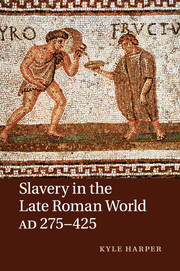Book contents
- Frontmatter
- Contents
- List of tables
- Acknowledgments
- PART I THE ECONOMY OF SLAVERY
- Introduction
- 1 Among slave systems: a profile of late Roman slavery
- 2 The endless river: the supply and trade of slaves
- 3 Oikonomia: households, consumption, and production
- 4 Agricultural slavery: exchange, institutions, estates
- PART II THE MAKING OF HONORABLE SOCIETY
- PART III THE IMPERIAL ORDER
- CONCLUSION
- APPENDIXES
- Bibliography
- Index
Introduction
Published online by Cambridge University Press: 05 August 2011
- Frontmatter
- Contents
- List of tables
- Acknowledgments
- PART I THE ECONOMY OF SLAVERY
- Introduction
- 1 Among slave systems: a profile of late Roman slavery
- 2 The endless river: the supply and trade of slaves
- 3 Oikonomia: households, consumption, and production
- 4 Agricultural slavery: exchange, institutions, estates
- PART II THE MAKING OF HONORABLE SOCIETY
- PART III THE IMPERIAL ORDER
- CONCLUSION
- APPENDIXES
- Bibliography
- Index
Summary
CONQUEST AND CAPITAL: THE PROBLEM OF SLAVERY IN ROMAN HISTORY
The Roman empire was home to the most extensive and enduring slave system in pre-modern history. Slavery has been virtually ubiquitous in human civilization, but the Romans created one of the few “genuine slave societies” in the western experience. The other example of classical antiquity, the slave society of Greece, was fleeting and diminutive by comparison. Stretching across half a millennium and sprawling over a vast tract of space, Roman slavery existed on a different order of magnitude. Five centuries, three continents, tens of millions of souls: Roman slavery stands as the true ancient predecessor to the systems of mass-scale slavery in the New World. We cannot explain the Roman slave system as the spoils of imperial conquest. Roman slavery was a lasting feature of an entire historical epoch, implicated in the very forces that made the Roman Mediterranean historically exceptional. Military hegemony, the rule of law, the privatization of property, urbanism, the accumulation of capital, an enormous market economy – the circulation of human chattel developed in step with these other characteristic elements of Roman civilization.
This book is a study of slavery in the late Roman empire, over the long fourth century, ad 275–425. Throughout this period, slavery remained a vigorous institution. The primary spokesmen of the age provide vivid testimony to the importance of slavery. Augustine, bishop of Hippo on the coast of North Africa, could claim that “nearly all households” owned slaves.
- Type
- Chapter
- Information
- Slavery in the Late Roman World, AD 275–425 , pp. 3 - 32Publisher: Cambridge University PressPrint publication year: 2011

